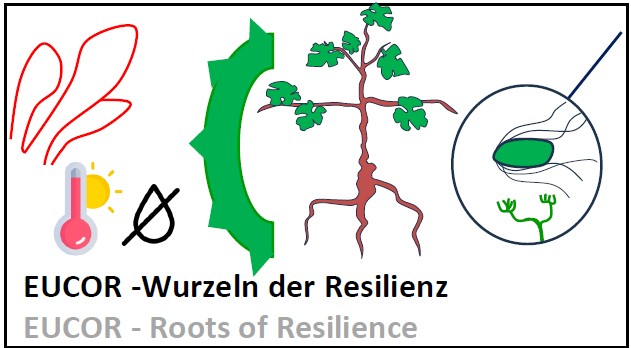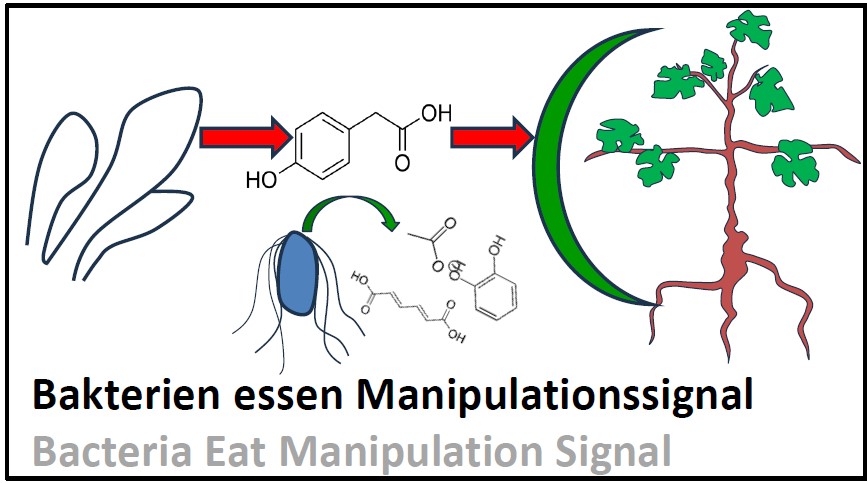 |
M4F News: EUCOR Project Roots of ResilienceEUCOR, the trinational assocation of Upper-Rhine universities (Karlsruhe, Strasbourg, Freiburg, Colmar-Mulhouse, Basel) launched a call for so-called Seed Money projects. Here, partner KIT-JKIP (Islam Khattab, Peter Nick) together with the University of Basel (Pascale Flury) and the Université Haute-Alsace (Julie Chong) was successful with the project Roots of Resilience. The project tries to render grapevine more resilient against climate-change born novel fungal diseases ("Esca & Co") through improved microbial communities in the rhizosphere. The project is based on results of Kliwiresse, but also previous Upper Rhine Interreg projects, especially Vitifutur and DialogProTec. However, the central reason for the success of the proposal was the cooperation cultivated over four Interreg Upper Rhine networks. The Seed Project in turn will feed into the planned sequel project Robin Root. Planned start is February 2025, running time is two years. more... |
|
 |
29.11.2024: Bacteria Eat Hijacking SignalOur previous work could show that the Esca fungus Neofusicoccum parvum secretes 4-Hydroxyphenyl Acetic Acid (4-HPA) to silence host immunity and to colonise the trunk. We could show that addition of biochar to the rhizosphere can block the spread of the fungus. But how does this work? Through complex bioinformatics analysis, Dr. Islam Khattab could show that biochar favours specific bacteria. Now, he discovered, how these bacteria support the plant: By identifying their metabolic pathways, he demonstrated that these bacteria specifically degrade 4-HPA. Thus, they eliminate the chemical signal, by which the fungus can hijack plant immunity. In the next step one can try to develop a kind of "vaccination". However, this "vaccination" is not based on antibodies, the role of antibodies is played by beneficial bacteria. |
|
 |
19.07.2024: The Role of NitrogenEsca & Co are not new diseases. New is just their epidemic spread in consequence of climate change. Our research on plant immunity showed that the outbreak of symptoms is linked with a disturbed chemical communication between wood-colonising fungi and the host plant. Some of the signals we were even able to identify. Central are phenolic plant compounds that are either formed as defence compounds against microbes, so-called phytoalexins, or as precursors of lignin, the building block of wood. When, due to climate stress, lignin formation is slowed down, these precursors accumulate, which is sensed by the fungus as indication for a weakened host. The entrance in this metabolic pathway is the amino acid phenylalanine, releasing ammonium. Ammonium is also central to a second entry gateway - the binding oto the amino acid glutamate, leading to the formation of glutamine, from where this amino group is then passed on for the formation of all the other amino acids. Thus, the formation of proteins and the formation of phenolic compounds are tightly linked. Can we use this link to mitigate disease outbreak by changing nitrogen levels (for instance through microbes or specific fertilisation)? Dr. Elnaz Zareei came with a Georg-Forster Research Grant for two years from Iran to the JKIP to investigate exactly this question. |
|
 |
24.11.2023: Optimised MicrobiomeThe project is based on the idea that microbes in the rhizosphere can stimulate grapevine immunity. Our work shows that Esca & Co are stress-dependent diseases that result from a perturbed communication between the eliciting fungi and the host plant. Key is ferulic acid that accumulates, when the grapevine is facing climate stress, which is interpreted by the fungus as "surrender signal". The fungus responds to this signal by secreting Fusicoccin A, which in turn acts as suicide signal for grapevine cells, such that the fungus kills the cell and exploits its resources for its own sexuality, enabling sporulation and the search for a new host. We asked now, whether we can suppress the accumulation of ferulic acid by changing the microbiome in the soil. This would prevent fungal toxicity even under stress conditions. Our lever was terra preta, which was added to the soil. In a large experiment using controlled conditions, we could show that this improves the symptomatics significantly, which is accompanied by the activation of immunity genes. But how is the microbiome changed? The metagenome data from this experiment were now analysed in the Master thesis of Tyra Magold. The bioinformatic analysis demonstrated significant shifts in species composition and incidence of specific microbes. Some of these microbes correlate with a better immune reaction of the plant. The next step will be to test, whether this statistic correlation is due to a causal relationship. If this succeeds for one of the identified candidate microbes, this would allow to design new therapies against Esca & Co. |
|
 |
01.08.2023: Healthy CommunicationEsca & Co is actually a stress conditoin - the causing fungi can live many years in the grapevine trunk without causing symptoms. When the plant is exposed to climate stress, as it happens more and more often even in our region, the fungus can sense this and kills its host. In a cooperation with the Institute for Bioactive Compounds (IBWF) in Kaiserslautern we could show that the stressed host accumulates ferulic acid, because this precursor of the wood substance lignin cannot be integrated. The fungus Neofusicoccum parvum has "learnt" to recognise ferulic acid as signal for the crisis of its host and responds bei producing Fusicoccin A, by which it drives the host into suicide, such that it can scavenge the corpse and extract the energy to generate spores for searching a new host. But what happens, when the host is healthy? Then the fungus generates 4-Hydroxyphenyl Acetic Acid, acting as growth promoter that manipulates host immunity in a way that the compound pterostilbene cannot be formed - this is the defence compound targeted against this fungus. Thus, in the absence of climate stress, the fungus might even be beneficial. Can we modulate this sophisticated chemical communication in a way that even under climate stress 4-Hydrophenyl Acetic Acid continues to be formed? This would suppress the outbreak of the disease. That is exactly what we try in frame of our project Microbes for Future (M4F) supported by the Strategic Funds of the KIT presidium. Our work on "healthy communication" has now appeared in the high-ranking journal Plant Cell & Environment:202. Flubacher NS, Baltenweck R, Hugueney P, Fischer J, Thines E, Riemann M, Nick P, Khattab IM (2023) The fungal metabolite 4-hydroxyphenylacetic acid from Neofusicoccum parvum modulates defence responses in grapevine. Plant Cell & Environment, doi 10.1111/pce.14670 - pdf
|
|
 |
01.01.2023: KliwiresseOctober 1, 2022 our new Interreg-Upper Rhine project Kliwiresse has been launched. A research net, coordinated by the Botanical Institute with partners from three countries in the region works to adapt viticulture to climate change. In many places, new vineyards can be laid down only with artificial irrigation, leading to conflicts with the supply of drinking water. We ask the ancestor of our grapevine, the almost extinct European Wild Grapevine, for help. Here, we search for genes that help to cope with heat, UV and drought stress, to cross them into cultivated grapevine. We will employ cutting edge technologies such as automised microscopy, non-targeted metabolomics, or double haploidisation. Goal are ´KliWi-Grapes (for Klima-Widerstandsfähig, climate resilient) that are supposed to continue the success story of the PiWi-Grapes (for Pilz-Widerstandsfähig, fungal resistant) that had also been developed in our region. At the same time, for the rootstock and fruit grapes relevant in our region, we will develop knowledge based predictors of their climate resilience, to help winegrowers to adapt to climate change by adjusting their selections. The project runs for three years and will cost 2.8 million €, whereby 1.6 million € will be covered by Interreg Upper Rhine. more about Kliwiresse |
|
|
|
15.10.2022: How Climate Stress Sickens PlantsEsca & Co is actually a stress-induced disease. The responsible fungi can live in the wood for many years without causing symptoms. However, when plants are exposed to climate stress, what happens also in our region with increasing frequency, the fungus can sense this and shifts then to a different behaviour - he kills his host, steals the resources from its corpse, makes sex and runs away (it produces spores). The evolutionary meaning is that the fungus cannot expect much from a moribund host and, thus, needs to search for a new place to stay. The outbreak of Esca & Co is, therefore, steered by chemical signals. In a cooperation between the Institute for Biologically Active Compounds (IBWF) in Kaiserslautern we succeeded to clear up two of these signals. Under stress, ferulic acid accumulates in the wood of the grapevine trunk, because this precursor of lignin cannot be any longer converted. The fungus Neofusicoccum parvum has "learnt", to sense ferulic acid as signal for the ensuing crisis of its host and to respond by secretion of Fusicoccin A. Also Fusicoccin A is a signal. It evokes in grapevine programmed cell death, a type of cellular suicide that is actually meant for defence against biotrophic pathogens. These "modern" pathogens can turn the host cell into a kind of zombie that cannot help providing the intruder with sugar. The economically relevant diseases Grapevine Downy and Powdery Mildew are caused by such smart pathogens. The suicide of the zombie cell is efficient, because it tears also these biotrophic pathogens into death. For the defence against Esca & Co this type of defence is completely outplaced, though. Esca fungis live on cell corpses anyway, in technical terms they are necrotrophs. A host cell that kills itself, is for this fungus a convenient victim, therefore. Thus, Fusicoccin A manipulates plant defence in a way that is bad for the plant, but good for the fungus. We succeeded now to elucidate this sophisticated manipulation by chemical signals and publish this in the journal Plant Cell & Environment. Khattab I, Fischer J, Kazmierczak A, Thines E, Nick P (2022) Hunting the plant surrender signal activating apoplexy in grapevines after Neofusicoccum parvum infection, Plant Cell Environment doi.org/10.1111/pce.14468 - pdf
|
|
 |
27.07.2022: MikrobenkampagneUm Mikroben zu finden, die im Wurzelraum leben und das Immunsystem der Rebe stärken können, so dass sie Esca & Co besser widerstehen kann, planen für August 2022 eine Sammelkampagne in der gesamten Oberrheinregion. Hier brauchen wir die Hilfe von Winzerinnen und Winzern: wenn Sie in Ihrem Weinberg von Esca befallene Stöcke haben, können Sie uns kontaktieren. Wir entnehmen dann eine kleine Menge (ca. 1 Liter) Erde im Unterstockbereich, als Kontrollprobe Erde von gesunden Reben im selben Weinberg. Natürlich tun wir das sehr vorsichtig und schonend, um ihre wertvollen Rebstöcke nicht zu schädigen. Aus der Erdprobe wird dann die DNS extrahiert und mithilfe modernster Technologie (sogenannter Metagenomik) untersucht. Wir könne dann die Zusammensetzung der Mikrobenflora feststellen, um so "heilende" Mikroben zu finden, die auch in einem heißen und trockenen Sommer, wie er auch dieses Jahr wieder zu erwarten ist, der Pflanze dabei helfen, den Ausbruch des sogenannten apoplektischen Zusammenbruchs (rechts Bild) zu verhindern. Hier können Sie sich anmelden. |
|

